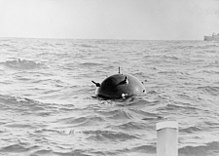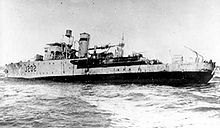International Mine Clearance Board

The International Mine Clearance Board (IMCB, German about: International Minenräumausschuss ) was at the end of World War II , founded by most European coastal states bordering organization whose task was to vacate the designated war mines to coordinate. The contracts for the IMCB were signed on November 22, 1945. The IMCB was dissolved in late 1951.
Threat to shipping from sea mines after World War II
During the Second World War, around 600,000 sea mines were laid in European waters alone . These were different types of ground and anchor towers. Most of these mines had not been cleared by the end of the war and presented a significant threat to shipping and fishing. In the years after World War II, a large number of ships were sunk or damaged by mines, killing or injuring many people. The most serious mine damage included the sinking of the Danish passenger steamer Kjobenhavn on June 11, 1948 off Aalborg with presumably over 150 deaths and the French frigate Laplace on September 15, 1950 west of St. Malo with 51 deaths.
Intensive mine clearance operations under the direction of the IMCB and other nations made it possible to reduce the mine hazard in the post-war years, but it has not yet been completely eliminated. This is especially true for ground mines. In the mid-1960s, ships that were not demagnetized were forced to stick to searched routes, as ignitable ground mines were still to be expected outside of these routes.
organization
All European coastal countries participated in the IMCB with the exception of Sweden and Turkey, which only sent observers. In addition, non-European nations such as Australia took part. The IMCB was based in London , where a staff of British, French, Soviet and US officers was formed. He transferred the clearance tasks to the coastal states. The European clearance area was divided into four zones:
- East Atlantic zone with Biscay , Canal , North Sea , British, Danish and Norwegian coasts,
- Kattegat and Baltic Sea accesses,
- Barents Sea / Baltic Sea / Black Sea Zone,
- Mediterranean zone .
In principle, all nations were responsible for mine clearance in their coastal waters. If that was not possible, international support was given. At the beginning of 1946 the Italian Navy received 32 mine sweepers from the British Royal Navy for clearing Italian waters.
For cooperation with civil shipping , the International Routeing and Reporting Authority (IRRA) was also set up in London, at the headquarters of the British Admiralty , which issued instructions and information on mine-free routes and sea areas, which were initially prescribed as so-called compulsory routes . For the European area, the North European and Mediterranean Route Instructions (Nemedri) were regularly published, which were published in the respective national news for seafarers . The NEMEDRI system existed until 1975.
German participation
From the day of the unconditional surrender of the Wehrmacht on May 8, 1945, German forces were obliged to participate in mine clearance in German and foreign waters in accordance with the requirements of the IMCB. For this task, the German Mine Clearance Service (DMRD), which is under British supervision and which at times had several hundred anti-mine vehicles , was formed from the Navy . The DMRD units were deployed off the West German, Danish, Dutch and Norwegian coasts.
Other German forces that were not part of the DMRD were deployed on the French coast under French leadership. There is no information about an operation under Soviet leadership in the Baltic Sea.
After the DMRD was dissolved at the end of 1947, the Cuxhaven Mine Clearance Association (MRVC) was set up, which continued the task until June 1951, also under British supervision. The clearing boats of this association were then handed over to the Labor Service Unit (B) belonging to the United States Navy and continued to be operated by German personnel. The coordination with the IMCB continued to be carried out by British bodies, which were supported by a naval service group in Cuxhaven consisting of German personnel .
Incidents and losses
During the clearance service a number of ships from different nations were lost to mine hits. A considerable number of people died in the process and in other accidents during the clearance service.
The most serious incidents in the course of the clearance work under the direction of IMCB were the Corfu Canal incidents , which occurred between May and November 1946. 44 men were killed and 42 injured in mine hits on the British destroyers Saumarez and Volage . HMS Volage was so badly damaged that it had to be decommissioned and scrapped.
In the DMRD, 53 crew members were killed in mine clearance accidents and 31 in a detonation on an ammunition dumping ship. Ten ships were lost. At the MRVC, three family members died in eviction accidents and a vehicle sank on a mine, injuring seven people.
During clearing work off the coast of Queensland , the Australian corvette Warrnambool ran into a mine on September 13, 1947 and sank. Four soldiers were killed in the process.
References
Web link
Individual evidence
- ↑ Letter of the British Government, Annex 3 (Engl.) ( Memento of 4 March 2016 Internet Archive ) (PDF, 1.6 MB)
- ↑ a b c Sea War Project of the Württemberg State Library
- ↑ Hartmut Klüver. The mine clearance association of the Cuxhaven Customs Border Guard. In: Hartmut Klüver (ed.); German maritime associations 1945–1956; P. 40 ff .; Düsseldorf 2001. ISSN 1438-907X . ISBN 3-935091-08-7
- ^ Project Sea War of the Württemberg State Library: Overview of ship losses through mines in European waters from 1945 - 1957
- ↑ Information at wrecksite.eu (engl.)
- ↑ Information at histomar.net (French)
- ^ German Hydrographic Institute. Baltic Sea Handbook, Part IV. Hamburg 1967
- ↑ Report at minesweepers.org.uk (Eng.)
- ↑ a b German Sea Associations 1945 - 1958 at mandors.de ( Memento from September 6, 2010 in the Internet Archive )
- ↑ Svensk uppslagsbok (swed.) ( Memento from July 14, 2012 in the web archive archive.today )
- ↑ Wolfgang Huebner. The Labor Service Unit (B) in Bremerhaven. In: Hartmut Klüver (ed.): Stations of German naval history (II): German Sea Associations 1945-1956, Düsseldorf 2001, ISBN 3-935091-08-7 . P. 62 ff.
- ↑ Udkik Maritime Dictionary (Danish)
- ^ Douglas C. Peifer. Three German navies - dissolution, transitions and new beginnings. Bochum 2007. ISBN 978-3-89911-101-9
Remarks
- ↑ also referred to as the International Central Mine Clearance Board, e.g. B. in the Australian Journal of Legal History (2005) Vol 9


